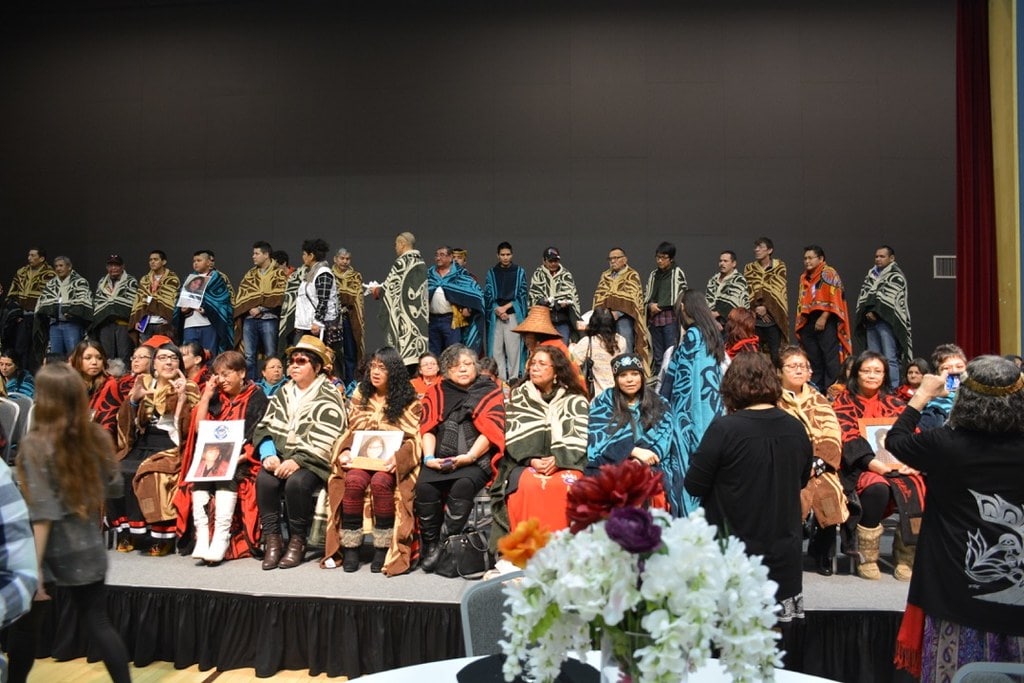Content warning: This article discusses the Missing and Murdered Indigenous Women and Girls crisis.
B.C. Gathering for families of missing and murdered Indigenous women and girls (BC Gov Photos)
Each day, every Indigenous woman wakes up to a nightmare. Otherwise, known as the dark reality of Canada. A reality where Indigenous women are 12 times more likely to go missing or be killed. A reality where 300 Indigenous women go missing in a year- of the known cases at least. However, this reality is masked with racism, ignorance, and largely, lack of awareness.
Colonialism’s Lasting Effects
The root of the ongoing racialization and sexualization of Indigenous women is no doubt connected to colonialism. It parallels the development of Canada itself, with the topic of settler colonialism being common amongst both. Colonists normalized violence against Indigenous women and families with the support of policies they created such as forced sterilization and losing their status if they married a non-Status Indigenous man. These policies served to limit Indigenous women’s access to community resources and safety networks.
Furthermore, Guthrie Valaskakis, a leading authority on Aboriginal Media and Communication, states that early colonial writing depicted Indigenous women as “Indian princesses” that were fetching, proud, and virtuous. The resistance to such views further catalyzed negative perspectives on Indigenous women. They became known as “squaws” that were dirty, lewd, uncivilized, and sexually deviant. This “heirloom” of intergenerational trauma is passed down through Indigenous families, often in the form of post-traumatic stress.
The Burden of Today
The aforementioned characterizations of Indigenous women certainly exist to this day. Thus, the grotesque violence that is covered for merely one Grade 6 class still continues today.
The fear and intergenerational trauma that Indigenous women and girls are burdened with have forced them to use coping strategies that increase their vulnerability to violence. These include hitchhiking, addictions, homelessness, and more. Perhaps one has seen these terms veiled as causes for their disappearances, when the real culprit, colonization, is stored away.
Is the Government Helping?
The answer to this is simply revealed in the negative effects of the Indian Act of 1876. Though published over a century ago, it is still in existence today. It is known that this sole piece of legislation restricted Indigenous people of their basic human rights. Relating to the matter of missing and murdered Indigenous women and girls, the Indian Act largely supports - and arguably has created - the discrimination and racism prevalent against Indigenous peoples today.
Primarily, the Indian Act is not inclusive when it comes to matrimonial real property (e.g. family home) on reserve land in the case of a marriage ending. Nothing in the Act affects title to reserve lands. As well, the rules on matrimonial property do not apply to First Nations that have signed the Framework Agreement on First Nations Land Management or those who have self-government arrangements. This lack of legal clarity and protection makes women who have been experiencing violence or recently widowed prone to losing their homes on the reserve.
In short, even one’s home is not a sustainable option when escaping from violent and unsafe situations.
Yes, one might argue that the government continues to promise to bring justice to this issue. However, like any other contemporary issue, it is part of a political agenda.
Three-Year Effort Down the Drain
An important and highly regarded document called the National Inquiry on Missing and Murdered Indigenous Women and Girls was published June 3,
- It concluded that years of systemic racism and human rights violations were a significant factor in the deaths and disappearances of hundreds of Indigenous women and girls. However, this call for action has continually been delayed by the government.
“Families, communities, and allies have not received any information about what governments – either federal or provincial – have been doing over the past year on this file,” said Meggie Cywink, whose sister disappeared on her respective birthday.
No glimpse of solace has been provided to affected families; they are left with grief and mocked with the government’s inaction. Even so, the COVID-19 pandemic has been used as an excuse for inaction. This is highly redundant as Indigenous women are at greater risk of violence due to the isolation measures in place.
The extensive report has created a descriptive framework and plan of action for the country, yet the government fails to act on it. It lists much-needed initiatives such as: legislation to preserve Indigenous languages; giving Indigenous communities control over their child-welfare systems; dealing with gender discrimination in the Indian Act.
The genocide that exists today is at the hands of the Canadian government. Each life is being dissolved into yet another statistic. It sounds an alarm for action but it is deafened with systemic racism and decades of oppression. Canada, please listen.
Rhea: This is an amazing article. Eloquent, passionate, forceful. It makes for very compelling reading. Very mature and thorough writing.
My only caution is: you don’t need the bitterness (flinch, not even a glance) to still make an extremely strong argument. It comes off better without resorting to a very personal level of attack. I totally agree with you on the facts and without the vitriol.
Excellent article and excellent writing.
